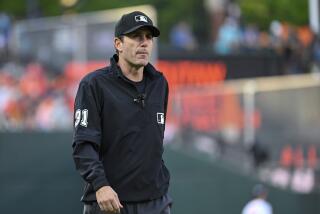Umpires Widely Abuse the Rule
- Share via
“Drive two six-foot poles 12 inches into the ground, 15 feet apart,” Branch Rickey said in a day when the world was young. “Place a home plate midway between the poles with the right angle apex of the plate exactly in line with the poles. Connect the poles with two parallel small strings, one shoulder high, the other knee high [top and bottom limits of the strike zone].
“Attach two very light strings to the top lateral string 17 inches apart, and wind the strings’ bottom extensions one or two loops around the lower lateral string, the two loops also 17 inches apart. . .
“Regardless of where a batsman stands, the strings create a visible strike zone in the pitcher’s mind. Pitching to the strings will accelerate the mastery of control. . . .”
With this simple blueprint, one of baseball’s great minds created a device that gave tangible shape to the strike zone. Hundreds of Brooklyn Dodgers pitched to those strings. The idea spread to every major league spring training camp (and even to my back yard after my father saw the strings in a newsreel).
But for all of Mr. Rickey’s genius, it’s now clear that he failed in a certain respect. He failed to see that words would lose their meaning. He didn’t know that the rule book would be tossed away. He didn’t know that in the later years of his century, the Imperial Umpire would read the rule book, study it and commit it to memory in order to ignore it and make up his own rules, such as this one currently in use. . . .
“When Mike Mussina throws a pitch where he intends to throw it, it’s a strike. Ditto for Greg Maddux.”
The strike zone debate is on again, given life by Mussina’s recent performance in which he retired the first 23 Tigers in a two-hit shutout. An assist went to plate umpire John Hirschbeck, whose strike zone is one with which Branch Rickey would not be familiar. Branch Rickey’s strike zone is a vertical rectangle. Hirschbeck’s is that rectangle laid on its side. An abomination.
The rule book says: “The Strike Zone is that area over home plate the upper limit of which is a horizontal line at the midpoint between the top of the shoulders and the top of the uniform pants, and the lower level is a line at the hollow beneath the kneecap. The Strike Zone shall be determined from the batter’s stance as the batter is prepared to swing at a pitched ball.”
The key words are “over home plate,” a width of 17 inches. Both the Orioles and Tigers said Hirschbeck’s strike zone may have been twice that wide. Even Mussina said, “John always has a pretty liberal strike zone,” confirmation coming from Oriole catcher Chris Hoiles.
He set up outside, halfway into the other batter’s box. Then Mussina hit Hoiles’ target. Good enough for Hirschbeck, whose strike calls on unreachable pitches provoked profanity from two Tiger hitters and Manager Buddy Bell, the skipper last seen holding his hands two feet apart, as if questioning a fish story, which he was.
All three Tigers were ejected, outfielder Bobby Higginson saying, “If you watch it on tape, it’s a disgrace. As players, we’ve been trained since we were 7 not to swing at that pitch. When you start calling strikes on pitches a foot outside, it’s physically impossible to hit.”
The rule-book strike zone has been gone a while. Pitches above the belt are no longer strikes, and maybe for good reason; the top of the strike zone changes with a hitter’s stride. But there is no such reasonable explanation for widening the zone.
Still, it’s done. And now we know it’s done with baseball’s approval. Marty Springstead, the American League’s supervisor of umpires, confirmed it by saying, “Every umpire has their own strike zone.” Springstead told Thomas Heath of The Washington Post, “Strike zones are a very hard thing to define. People think you can take the rule book and paste it up on home plate and that’s your strike zone. People don’t think of all the variables that come into it. You’ve got guys that bat from the left, guys that bat from the right, knuckleball throwers, fastballs, curveballs. You have umpires that are 6-6, 5-10, umpires whose stances are squared off, scissors, on your knees, on the slot.”
Pardon, Mr. Springstead, but what does any of that have to do with the plate being 17 inches wide? Well, he said, some pitches may look outside when in fact an edge of the ball passes over an edge of the plate. Oh, please.
Makes me wish Branch Rickey had perfected a 1950 experiment. He asked General Electric engineers to design a machine of three mirrors and electric eyes. If a pitch came through the strike zone, the mirrors saw it in 1-2-3 order and electric impulses lit a lamp, indicating a strike. Otherwise, it was a ball.
Anyway, if I’m a major league hitter, the next time I go to bat with John Hirschbeck behind the plate, here’s what I do. I go to the local picnic lake and find a rowboat and I borrow an oar and I put it on my shoulder and walk to the plate and say to Mr. Hirschbeck, “If this doesn’t work, I’m coming back with a flagpole.”
More to Read
Go beyond the scoreboard
Get the latest on L.A.'s teams in the daily Sports Report newsletter.
You may occasionally receive promotional content from the Los Angeles Times.










